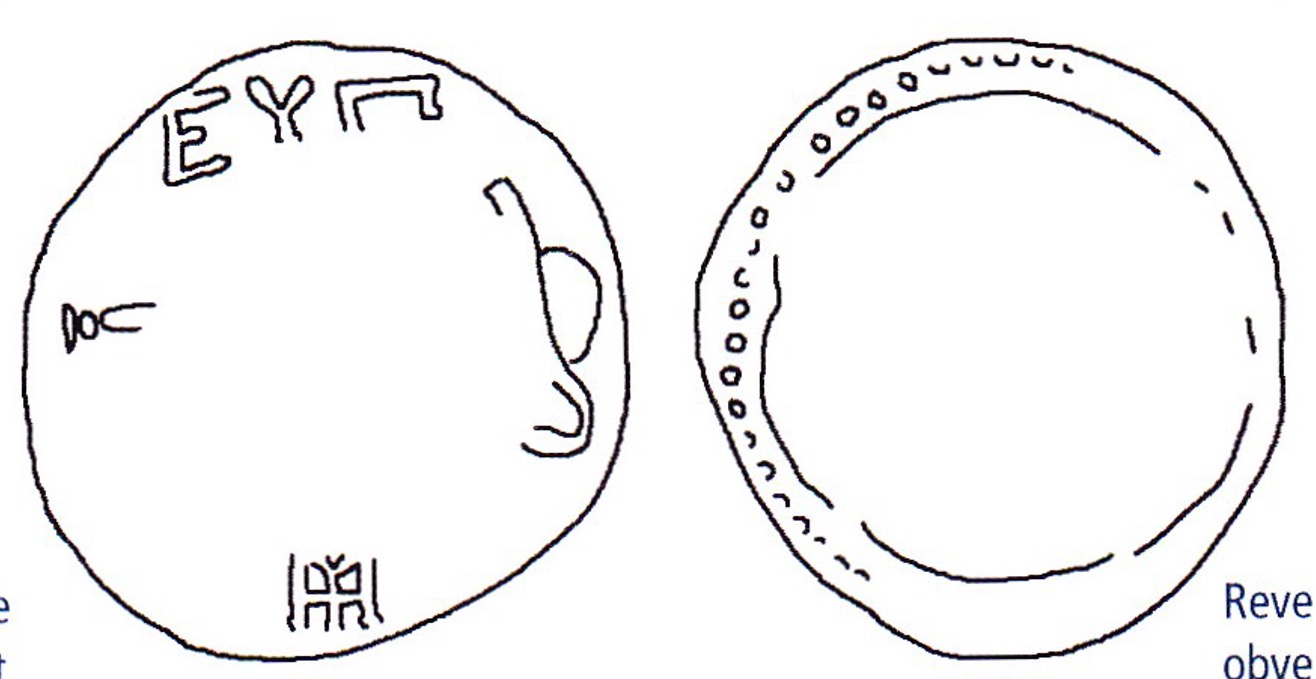2400 - Etenna (AE nymph/knife) over Mylasa or Caunus? (shields/sword) (MacDonald coll., 131)
From SILVER
100 BCE - 30 BCE | ΕΤ
Images
Overstruck variety Traces of the overstruck variety
Traces of the overstruck variety

Eupolemus_shields-sword.jpeg [1]
Location/history
| Private collection(s)Private collection(s) ᵖ: | David MacDonald collection |
Overstriking coin
Description
| ObverseInscription or printing placed on the obverse.: | Nymph facing, with serpent wrapped around her. Behind, overturned oinochoe. | ReverseInscription or printing placed on the reverse.: | ΕΤ (Greek) Sickle-shaped knife. |
Mint and issuing power
| MintIdentifies the place of manufacture or issue of a numismatic object.: | Etenna | Ancient regionAncient region. | Pisidia | Modern countryModern country: Turkey | AuthorityIdentifies the issuing power. The authority can be "pretended" when the name or the portrait of X is on the coin but he/she was not the issuing power. It can also be "uncertain" when there is no mention of X on the coin but he/she was the issuing power according to the historical sources: |
Chronology
| FromIdentifies the initial date in a range assigned in a numismatic context. 100 BCE toIdentifies the final date in a range assigned in a numismatic context.. 30 BCE | Hellenistic 323-30 BC |
Physical description
| MetalThe physical material (usually metal) from which an object is made.: Bronze |
WeightWeight of the numismatic object (in grams). in grams: 3.253.25 g <br />3,250 mg <br /> | AxisDescribes the directional relationship between the obverse and reverse of a numismatic object.: 11 mm <br />0.1 cm <br /> | |
| DiameterDescribes diameter of an object (in mm).: 1818 mm <br />1.8 cm <br /> | |||
References
| Coin referenceReference of the Coin: | MacDonald 2009, p. 176-7, n° 131. | Coin series referenceReference to coin series study: | SNG Copenhagen Pisidia1SNG Copenhagen Pisidia, n° 146, SNG von Aulock Pisidien2SNG von Aulock Pisidien, n° 5018, SNG France 33SNG France 3, n° 1538-1540 |
| Coin series web referenceCoin series web references: | |||
Overstruck type
Description
| ObverseInscription or printing placed on the obverse.: | Three Macedonian shields overlapping one another (visible on reverse: edges of shields). | ReverseInscription or printing placed on the reverse.: | ΕΥΠΟΛΕΜΟΥ (Greek) Sword in sheath and monogram 'MP' (visible on obverse: top and bottom of sword, monogram, ΕΥΠ). |
Mint and issuing power
| MintIdentifies the place of manufacture or issue of a numismatic object. ᵖ: | Caunus; Mylasa | Ancient regionAncient region. ᵖ | Caria | Modern countryModern country: | AuthorityIdentifies the authority in whose name (explicitly or implicitly) a numismatic object was issued. ᵖ: | Eupolemus (general of Cassander, Macedonian strategos in Caria, after c. 315 BC) |
Chronology
| FromIdentifies the initial date in a range assigned in a numismatic context. 305 BCE toIdentifies the final date in a range assigned in a numismatic context.. 285 BCE | Hellenistic 323-30 BC |
Physical description
References
| Coin type referenceReference to coin series study ᵖ: | BMC Caria4BMC Caria, Mylasa, p. 128, n° 4-6, SNG Copenhagen Macedonia III5SNG Copenhagen Macedonia III, n° 1165-1169, SNG von Aulock Karien6SNG von Aulock Karien, n° 2378, Ashton 19987Ashton 1998, Caunus | ||
| Coin series web reference overstruckCoin series web references overstruck: | |||
Additional data
| Frequency of overstrikesFrequency of overstrikes: | Level of confidenceLevel of confidence of the identification: | ||
| RemarksRemarks: | |||
References
- ^ Breitenstein, Niels (1956), Sylloge Nummorum Graecorum: Royal Collections of coins and medals. Danish National Museum, 32, Pisidia.
- ^ Sylloge Nummorum Graecorum. Sammlung v. Aulock. Pisidien - Lykaonien - Isaurien. 12 Heft (n° 4894-5412), Berlin, 1964.
- ^ Levante, Edoardo [with the collaboration of Peter Weiss] (2001), Sylloge nummorum graecorum. France. 3, Département des monnaies, médailles et antiques : Pamphylie, Pisidie, Lyaconie, Galatie, Paris-Zürich, Bibliothèque nationale de France-Numismatica Ars Classica, XXXIV + 293 p. and 146 pl.
- ^ Head, V. Barclay (1897), A Catalogue of the Greek coins in the British Museum. vol. XV : Caria, Cos, Rhodes, etc., London, The Trustees, p. 325, pl. XLV.
- ^ Breitenstein, Niels (1943), Sylloge Nummorum Graecorum: Royal Collections of coins and medals. Danish National Museum, 10, Part. 3 Philip III - Philip VI, Macedonia under the Romans, Kings of Paeonia, 35 pl.
- ^ Sylloge Nummorum Graecorum. Sammlung v. Aulock. Karien. 7 Heft (n° 2334-2867), Berlin, 1962.
- ^ Ashton, Richard (1998), "The coins of the Macedonian kings, Lysimachos and Eupolemos in the Museums of Fethiye and Afyon", in: Hersh, Charles - Burnett, Andrew M. - Wartenberg, Ute (ed), Coins of Macedonia and Rome : essays in honour of Charles Hersh, London, Spink, p. 19-48, pl. 1.

